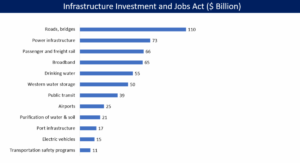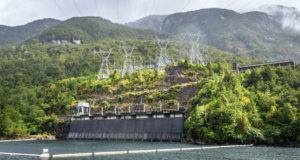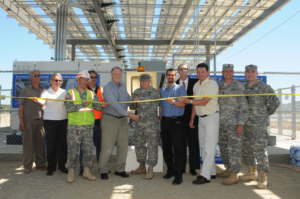February 23, 2022 – Volume 24, Issue 2
In This Issue
- Flanigan’s Eco-Logic: The Hydrogen Shot
-
The Angeles Link – Green Hydrogen for LA
- Federal Funding for Amtrak, EV Charging, and Hydrogen
-
Green Hydrogen in Spain and New Zealand
-
100-Hour, Iron-Air Battery Storage
- Army Green News
- Rooftop Community Solar in New York
- Embodied Carbon in Buildings
- The NetPositive Podcast Updates

Flanigan’s Eco-Logic: The Hydrogen Shot
Reminiscent of the Moon Shot that put Neil Armstrong on the lunar surface, and like the U.S. Department of Energy’s 2011 Sun Shot that helped drive down the costs of solar, the Hydrogen Shot Initiative is an industry challenge to drive down the cost of clean hydrogen. The target is $1.00 per kilogram by 2032. That’s an 80% reduction in cost.
On June 7, 2021, Secretary of Energy Jennifer Granholm announced the Energy Earthshots Initiative to accelerate breakthroughs of more abundant, more affordable and reliable clear energy solutions within the decade. The first Energy Earthshot is the Hydrogen Shot. To put its $1/kg goal for clean hydrogen in perspective, commercially available hydrogen today costs about $2/kg in the United States and $5 – 6/kg in Europe.
But the key is the color! “Gray hydrogen” sets the baseline price at ~$2/kilogram. Most of the 10 million metric tons of hydrogen produced in the U.S. each year is from natural gas through steam methane reforming. Hydrogen is stripped off natural gas. That’s the gray stuff!
Green hydrogen is made by zapping water with renewable electricity, using an electrolyzer to split water molecules to produce hydrogen and oxygen with virtually no greenhouse gasses or criteria pollutant emissions. This has cost $10 – 15/kg. Fortunately, green hydrogen costs have fallen to $3.00 – 6.55/kg according to a European Commission 2020 report. That same report stated that fossil-based, gray hydrogen had dropped to $1.80/kilogram.
A few more hydrogen colors: “Blue hydrogen” is made by stripping hydrogen from natural gas and sequestering the carbon. “Brown hydrogen” is made from coal. In concept, “pink hydrogen” takes high temperature nuclear reactor waste heat to boost renewably powered electrolyzers’ efficiency.

To ramp up green hydrogen production, and given inefficiencies in converting to and from hydrogen, there is a profound need for access to low-cost electricity. It can be sourced from wind, solar, or geothermal… as long as it is green and sustainable. Then there’s the technology side… the manufacture of electrolyzers. A rise in demand is resulting in more units; demand is driving down costs. Concurrently, electrolyzer efficiency is rising. Higher temperature electrolysis is also coming into focus to boost production.
The largest hydrogen electrolyzer in the world has been Baofeng Energy’s 150 MW facility in China. Larger facilities are already under construction. Bloomberg New Energy predicts that electrolyzer installations in 2022 will quadruple installations from last year. Without question, hydrogen is on the go… a storage medium, a fuel for power plants and vehicles… the “green stuff” will be a strategic element in our sustainable future.
The key to widespread use of green hydrogen is the renewable energy to power it and the cost of doing so. This EcoNet issue features several stories on green hydrogen, a brand-new initiative to pipe green hydrogen into the Los Angeles Basin, plus green hydrogen projects in Spain and New Zealand.
Fact of the Week
Major power cuts, a red alert in London, many homes lost power, flights canceled….Storm Eunice blew across London, southeast England, and parts of continental Europe.Eunice punched 80 mile per hour winds, gusts up to 122 mph.The fact and silver lining: Wind provided 42% of England’s electricity during the storm.
The Angeles Link – Green Hydrogen for LA

Just this past week, Southern California Gas made a major announcement about green hydrogen. It has submitted an application to the California Public Utilities Commission to build the infrastructure and the pipelines to deliver green hydrogen into the Los Angeles Basin. Its plan is to develop the nation’s largest green hydrogen energy infrastructure program.
“The Angeles Link” is envisioned to supply enough green hydrogen to convert four natural gas power plants to green hydrogen, to fuel a number of essential industries, and to fuel 3 million vehicles. The project will consist of electrolyzers, energy storage, and pipelines. SoCalGas plans to use much of the excess wind and solar capacity that has been curtailed when supply exceeds demand. This energy will be put to use. The project involves 2,000 MW of energy storage and will require up to 750 miles of special hydrogen pipeline. Initially, the hydrogen system will deliver one quarter of the service level that SoCal Gas provides today with natural gas.
The SoCal Gas green hydrogen concept is ground breaking. It’s a means of powering cities of the future at any and all hours. To its proponents, the green hydrogen pipeline system is the missing link in the energy equation. Stay tuned for more details on its cost and scalability.
Federal Funding for Amtrak, EV Charging, and Hydrogen

The Infrastructure Investment and Jobs Act will fund $1 trillion in upgrades across America. The bill will funnel billions to states and local governments to upgrade roads, bridges, transit systems, railways, ports, clean water systems, and the electricity grid including EV charging. It is touted as bipartisan. It was signed by 19 Senate Republicans and 13 House GOP members and signed by the President on November 15, 2021. And now the money is flowing.
The U.S. lags behind the rest of the world in reliability, speed, and coverage of passenger rail. China already has 22,000 miles of high speed rail. The Infrastructure bill will direct a $66 billion infusion to eliminate Amtrak’s maintenance backlog, to modernize the Northeast Corridor, and to bring world-class rail service to areas outside of the northeast and mid-Atlantic. It will be the largest investment in passenger rail since Amtrak’s creation.

The Infrastructure bill also calls for an investment of $7.5 billion to build out a national network of electric vehicle (EV) chargers in the United States. The legislation directs funding for the deployment of EV chargers along highway corridors to facilitate long-distance travel. States are now getting the go-ahead to build a nationwide network that will place charging stations every 50 miles along the nation’s highways. It’s an important part of the Infrastructure bill, “sketching out a vision of seamless climate-friendly car travel from coast to coast.”
States can now submit plans and if approved can be building chargers this fall. The direction is clear: focus on the highway corridors – “alternative transportation fuel routes.” According to Consumer Reports, anxiety about limited range and the availability of charging stations are among the top concerns consumers have about EVs. Secretary of Transportation Pete Buttigieg suggested that the “big wide open spaces of the U.S. no longer need to be a valley of death for EV drivers.” He and Energy Secretary Granholm drive Ford Mustang MAC-E SUVs. She called building the network of chargers, “creating the spine of the national network” of EV chargers.
The Infrastructure bill provides money for clean hydrogen. The U.S. Department of Energy this past week announced $9.5 billion to advance the deployment of hydrogen and to drive down the cost of hydrogen. The goal: to get the cost of clean hydrogen to less than $1 per kilogram. The next step: two requests for information have now been sent out to the industry. The first RFI will use $8 billion to create Regional Clean Hydrogen Hubs.
The other billion dollars is to help shape the Clean Hydrogen Electrolysis Program. Its goal is to reduce the cost of hydrogen produced from clean electricity. The RFIs will gather input from regional leaders, local groups , environmental justice community members, researchers, and technology developers, to inform the design of clean hydrogen programs. Responses to the RFIs are due in March. The RFI guidance will hone DOE investments to spur hydrogen production.
Green Hydrogen in Spain and New Zealand

Hydeal Espana is touted as the world’s largest integrated renewable and competitive hydrogen hub. Located in Northern Spain, it’s the first industrial implementation of the HyDeal Ambition platform… a plan to deliver competitively priced renewable hydrogen to industrial complexes in Europe through what is called “the hydrogen stream.”
When fully built out, Hydeal Espana will consist of 9,500 MW of solar and 7,400 MW of electrolysis by 2030. It is slated to produce 6.6 million tones of annual green hydrogen. It is ranked as the largest giga-scale renewable hydrogen project in the world. Its output will be used to create green steel, green ammonia, green fertilizers, and other low-carbon industrial and energy products.

Image Courtesy of Meridian
In New Zealand, the largest hydroelectricity generator the 800 MW Manapouri plant, currently supplies the Tiwai Point Aluminum Smelter that consumes ~12% of New Zealand’s electricity. The smelter is being closed and its power supply agreement expires in 2024. That frees up 438 GWh of renewable power annually for another use.
The planned Southern Green Hydrogen Project will use that power and will develop 600 MW of electrolyzers to establish large-scale green hydrogen production and export facilities. Meanwhile, one of the project partners, the Australian FFI, plans to convert New South Wales’ coal generators to green hydrogen, and to build the world’s largest electrolyzer plant there.
100-Hour, Iron-Air Battery Storage

Image Courtesy of Form Energy
An old battery chemistry is being dusted off… iron-air batteries. And they may compete well, or complement, lithium-ion batteries. They’re based on the use of iron pellets. Massachusetts-based Form Energy is running with the ball! Its batteries use an iron-air exchange, flow-battery technology. Known for decades, the rechargeable iron-air battery has several features: It is low cost, safe, durable, and can be readily scaled since the technology is based on three cheap and readily available materials: iron, air, and water, versus critical minerals for other battery chemistries. Iron-air has the promise to be one-tenth the cost of lithium-ion, and easily recyclable. And because the cost is low, these batteries can provide long duration energy storage, defined here as 100 hours!
The iron-air batteries harnesses the process of “reversible rusting.” They convert iron to rust back and forth. While discharging, the battery breathes in oxygen from air and converts iron metal to rust. While charging, the application of an electrical current converts the rust back to iron and the battery breathes out oxygen. This low-cost “solution” for multi-day storage has attracted over $200 million in investments.
Each individual battery module is “about the size of a washing machine.” Form reports that each battery has the capacity equivalent to a Chevy Bolt (65 kWh). Each module or cube is filled with water-based, non-flammable electrolyte. Bathed in liquid electrolyte are stacks of 10 – 20 meter-scale cells, which include iron electrodes and air electrodes.
Big news is that Georgia Power will collaborate with Form Energy to develop an energy storage project that will be 15 MW and a whopping 1,500 MWh in size, creating long-duration energy storage. This will be Form’s largest deployment. It also has an agreement in place with Great River Energy, a cooperative in Minnesota for a battery system there. Incidentally, one megawatt requires about an acre of land. If they are stacked, Form suggests an output of 3 MW per acre.
Form Energy is backed by Breakthrough Energy Ventures, which is led by Bill Gates. It is also backed by Southern Company, Georgia Power’s parent. Form believes it can produce batteries with 100 hours of storage at a cost of less than $20/kWh.
Georgia Power appears to be on a roll, committed to retire all coal by 2028 and to install 2,300 MW of solar in the next three years. The utility Is building big batteries: It has built the 65 MW / 260 MWh Mossy Branch Battery Facility. It plans to install 265 MW / 530 MWh of battery energy storage at its McGrau Substation north of Atlanta. The utility’s recent Integrated Resource Plan also calls for long-duration energy storage to complement these four and two hour systems. Thus the Form fit.
Army Green News

The U.S. Army plans to install a microgrid at every one of its 130 bases worldwide by 2035. According to Microgrid Knowledge, the military has been an advocate and an early mover on microgrids for years. Microgrids bring energy independence to the military facilities. Many of these were powered with generators. Now they will be carbon-free.
The Defense Department is focused on enhancing the safety of soldiers already experiencing effects of climate change. The DOD has long called climate change a “threat multiplier.” It exacerbates many of the challenges the armed forces have to deal with… extreme conditions. It is planning to procure renewables and storage to self-sustain its critical missions on all Army installations by 2040. The Army’s goal is to reduce GHG emissions to 50% of 2005 levels by 2032, and to net zero emissions by 2050.
Three notable military microgrids already exist. They are at Fort Hunter Liggett in California, the Redstone Arsenal in Alabama, and Fort Bragg in North Carolina. Another 24 projects are in planning stages. The Army is also working on microgrids for its “Contingency Bases.” These are temporary sites that the Army wants to make less reliant on fossil fuels.

The microgrid announcement is part of a larger climate strategy. The Army’s climate plan calls for electrifying its vehicle fleets. Its goal is to make its non-tactical light vehicles electric by 2027, and then all remaining non-tactical vehicles electric by 2035. The Army is also planning for all tactical vehicles to be first hybrid by 2035 and then fully electric by 2050. In addition to lowering emissions, electric vehicles allow vehicle electronics to be operated with their engines shut off, making them quieter and cooler, and thus harder to hear or to see through infrared vision.
Rooftop Community Solar in New York

Image Courtesy of SUNation Solar Systems
Long Island, SUNation, and Karp. The location, the developer, the site owner. Ten acres of rooftops host a 1.78 MW solar system. Who gets the power? Offtakers… some 175 community solar participants. They choose to invest in a community array. Some cannot host their own system, and want to go solar nevertheless. Community solar is an answer, a means for apartment owners, or renters, or those in the shade… to buy solar power and locally.
Long Island is about 100 miles long and 10 miles wide at its thickest. It’s valuable real estate, thus shifting community solar arrays from ground-mount arrays to rooftops makes sense. Karp Associates’ manufacturing facility in Melville, New York hosts the largest rooftop community solar project on Long Island. Karp manufactures industrial access doors and hatches. It is already green. It has retrofitted its lighting, invested in geothermal heating, the company recycles shipping materials, and uses no-emissions paint. And it has massive rooftops which it has rented for community solar.
The community solar project is built and consists of two rooftops with 3,456 and 972 panels, LG 400 and 405-watt modules. The 1.78 MW project is part of SUNation’s 5 MW community solar plant aggregate capacity on Long Island, a region where about half of all ratepayers live in homes that are not conducive to solar.
Embodied Carbon in Buildings

Image Courtesy of Skanska
There are two types of carbon associated with buildings, operational carbon and embodied carbon. Operational is the carbon related to the fuels that keep the building running. Embodied carbon is the energy used to build the building. How much carbon did it take to make the steel? The concrete? Embodied carbon refers to the total impact of all human-induced greenhouse gasses emitted from material extraction through the end of its useful life.
Building operations and construction are responsible for approximately 39% of global greenhouse gas emissions. More than a fourth of those are embodied carbon emissions, those associated with the production of building materials and construction activities. Most of these emissions are the result of steel and cement manufacturing. Aluminum, glass, and insulation manufacturing are secondary contributors.
The New Buildings Institute has recently released a report, “Lifecycle GHG Impacts in Building Codes.” It finds that as operational carbon emissions are reduced through efficient building codes and a cleaner power system, embodied carbon will become a larger part of a building’s total carbon emissions. In fact, embodied carbon may be responsible for nearly half of total new construction emissions between now and 2050. That certainly gives code developers food for thought. Just as we are successfully reducing operational emissions, can we also reduce embodied carbon emissions?
Hmmmm. Ten design commandments for how architects to achieve cost-effective emissions reductions: Design for 60 years plus, nothing short term. Avoid sites requiring deep foundations and expensive soil stabilization. Consider structural options. Would a lighter or timber frame work? Specify low-carbon materials. Optimize building shape. Use thinner floor slabs, etc. The list goes on. Clearly, there are potent solutions for building decarbonization of embodied carbon.
The NetPositive Podcast Updates

Recently Released:
- This issue of EcoNet News, Volume 24, Issue #2 is also available in podcast format
- The NetPositive Podcast: A Conversation on EV Charging with Kitty Adams, Executive Director and Founder of Adopt An EV Charger
- The NetPositive Podcast: A Conversation on Ultra- Efficient Building Design with Peter Rumsey, Principal and Founder of Point Energy Innovations
- The NetPositive Crash Course on Solar Net Energy Metering with Ted Flanigan, hosted by Sierra Flanigan
- The NetPositive Podcast: A Conversation with Nurit Katz, Chief Sustainability Officer, University of California at Los Angeles
Check out and subscribe to The NetPositive Podcast with Ted Flanigan on Spotify, Apple, and Google. Episodes include Convos (Conservations and Crash Courses), the News (EcoNet News), and Uni (the EcoMotion University).
